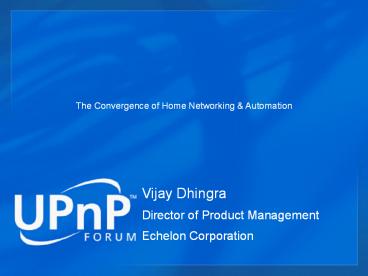The Convergence of Home Networking - PowerPoint PPT Presentation
1 / 12
Title:
The Convergence of Home Networking
Description:
Expensive and infeasible to implement UPnP stack in all home automation devices ... Option 1 - ANSI/CEA-709.1/UPnP Bridge Stack Using LNS ... – PowerPoint PPT presentation
Number of Views:70
Avg rating:3.0/5.0
Title: The Convergence of Home Networking
1
The Convergence of Home Networking Automation
Vijay Dhingra Director of Product Management
Echelon Corporation
2
Consumer Requirements
- Consumers who buy devices expect them to be
seamlessly integrated into their data/automation
network - Easy to configure and register
- Seamless integration between IP and
- non-IP networks
- Secure and reliable communications
- Intuitive controls
3
Seamless Integration of Automation Devices
- Automatic device discovery, self-configuration,
unobtrusive networking just like other UPnP
enabled devices - Devices dynamically join a network, convey their
capabilities, and learn about the presence and
capabilities of other devices - A wide selection of automation devices from
multiple manufacturers from which to choose
4
Why Is a Bridge Needed?
- Expensive and infeasible to implement UPnP
stack in all home automation devices - Motion sensors, lights, switches, etc.
- Need a connection to a pervasive home automation
network - A bridge connects UPnP enabled devices with
non-IP home automation devices
5
Network Architectures
- Two different types of network envisioned
- Managed network
- For small commercial applications with a
service-based model - Self-installed network
- For home networking and home automation
environment with or without service-based model - Single vendor solution
- Multi-vendor solution
6
LONWORKS to UPnP Bridge
MobileDevices
RF
LONWORKS Network
7
Architecture of the Solution
- UPnP Protocol (Intel SDK)
Translation Layer
ANSI/CEA-709.1 Network
8
Option 1 - ANSI/CEA-709.1/UPnP Bridge Stack
Using LNS
- Pluggable architecture using LNS object interface
UPnP Technology
UPnP Stack (Intel SDK)
Object Translation Layer
Functional Blocks
Self-installation with Discovery
LONWORKS
LNS
Database Server
ANSI/CEA-709.1 Software Stack Layers 2 to 6
9
Option 2 ANSI/CEA-709.1 / UPnP Bridge Stack
Using OpenLDV
- Pluggable architecture using OpenLDV interface
UPnP Technology
UPnP Stack (Intel SDK)
Object Translation Layer
Functional Blocks
Discovery
SS API
Database Server
OpenLDV
LONWORKS
ANSI/CEA-709.1 Software Stack Layer 2 to 6
10
ANSI/CEA-709.1 to UPnP Object Translation Layer
Options
- Single UPnP enabled device portal style
- Presentation page-based, catch-all-devices UI
interface - Bridge as single UPnP device
- Discovery (SSDP) is mandatory
- Bridge-level control and eventing are optional
- Remote UI is the only access point to individual
functional blocks - Network Address Devices devices or functional
blocks - A collection of UPnP enabled devices
- Each functional block or ANSI/CEA-709.1 device
exposed as a separate UPnP device - Discovery, control, eventing supported with
device or functional block object-level
granularity - Each functional block can have a remote UI
11
ANSI/CEA-709.1 Network Management and Data Access
Options
- Option 1LNS based managed network
- Standard, complete network management
- Includes self-configuration algorithm
- Database automatically synchronized to the
network - Standard data formatting and localization
- Ideal for service provider mass deployments,
individual large home networks, and enterprise
solutions - Option 2Self-installed network
- Includes self-configuration algorithm
- Bridge passively learns network configuration and
bindings - No active network management query device
identity / type only (not required can be
passive listener) - Ideal for typical home networks
12
Foundation of the Connected Home































